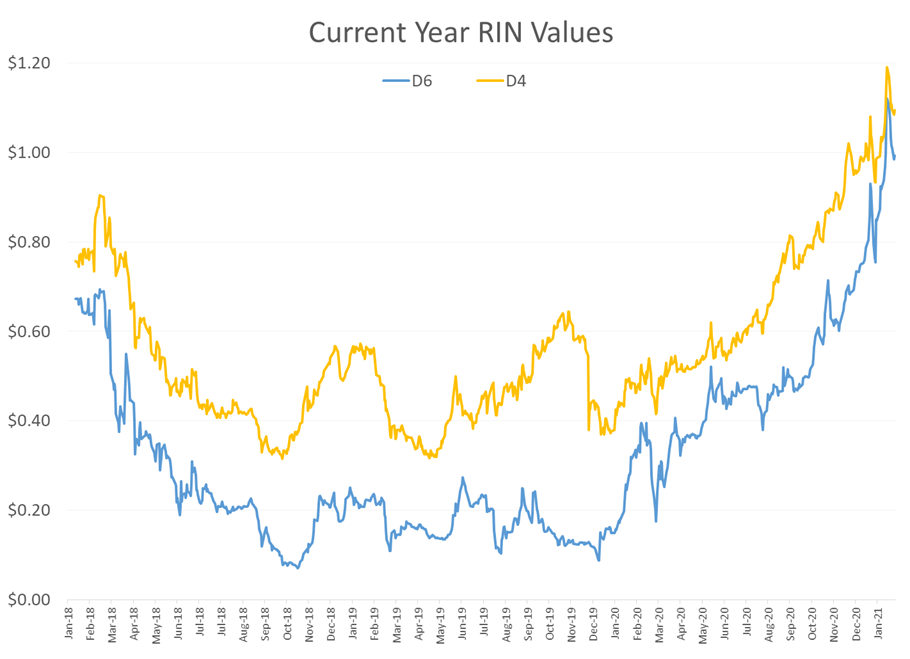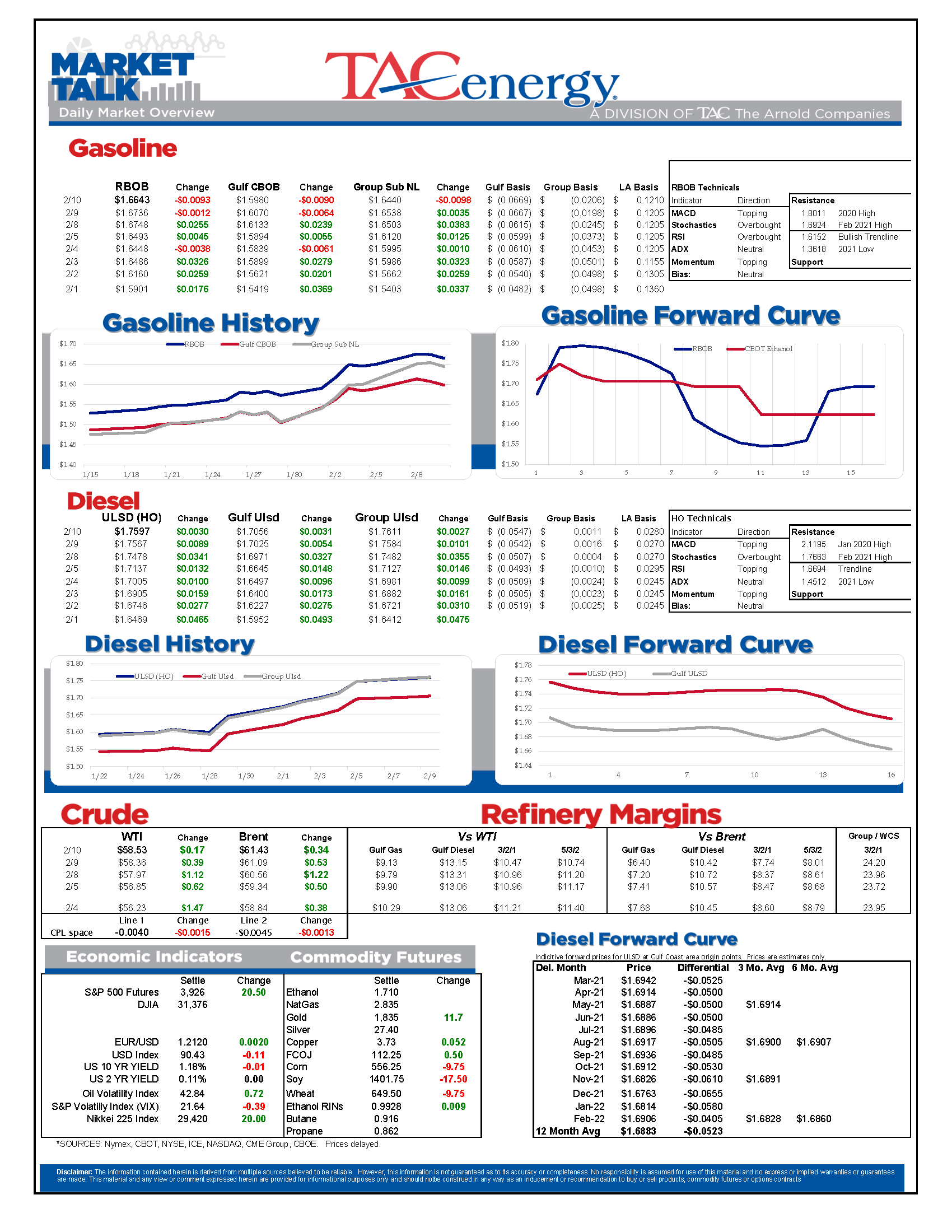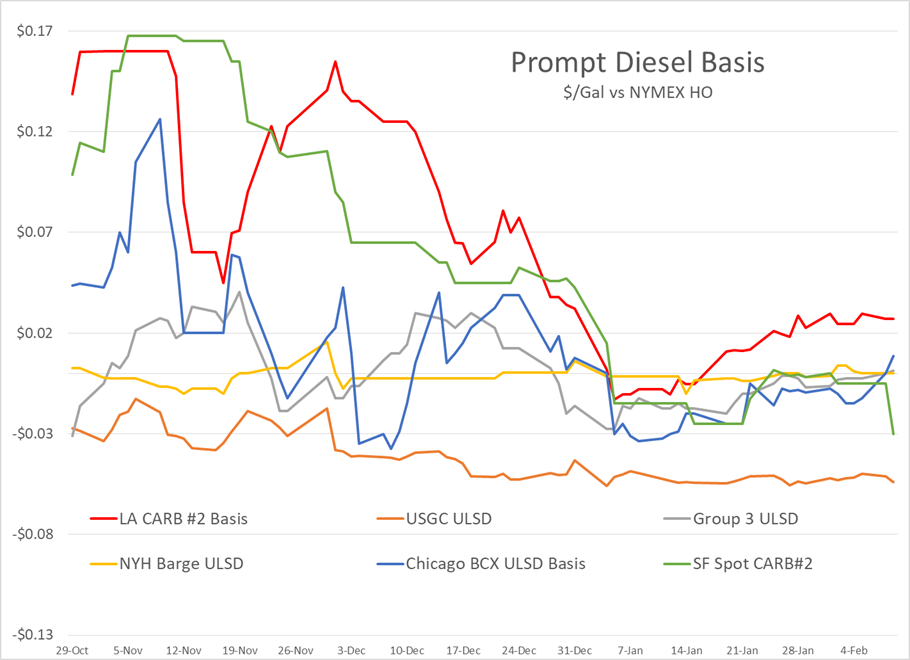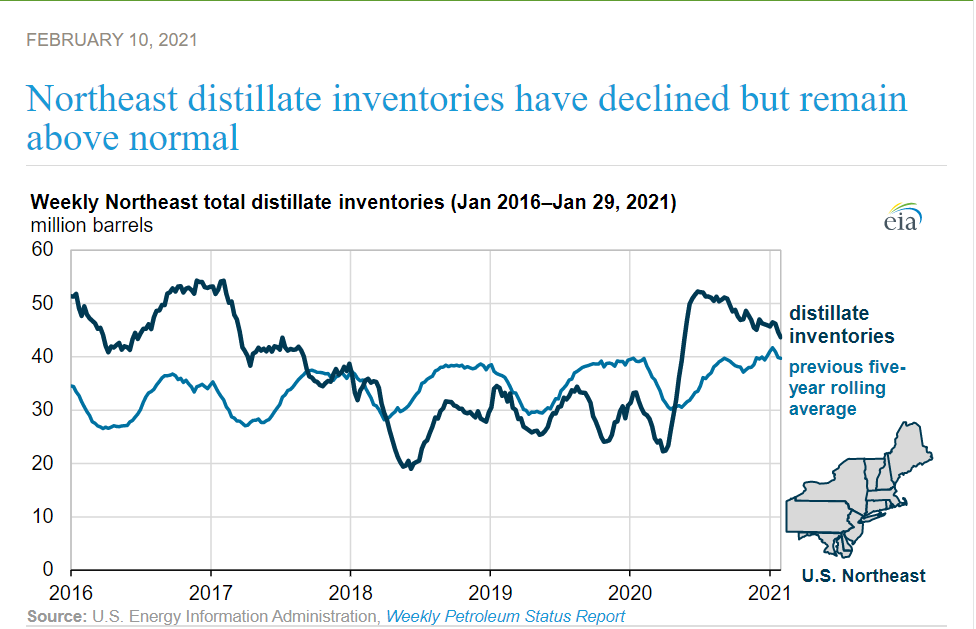Parade Of Winter Storms Hits Demand Across The Country

Oil and diesel prices are moving higher for an eighth straight day after Tuesday morning’s attempted sell-off proved to be short-lived. RBOB prices are struggling to keep up so far after a large build in U.S. gasoline inventories gave traders reason to pause. Tuesday’s bounce keeps the bullish trend lines intact, and the path open to test the 2020 highs set before COVID lockdowns became a reality even as more fundamental signs suggest this rally may have outkicked its coverage.
The API was reported to show a 3.5 million barrel draw in oil inventories last week, while distillates declined by just under ½ million barrels. A large build in gasoline stocks of 4.8 million barrels seems to be the reason that the March RBOB contract is the only one of the big 4 petroleum futures trading in the red this morning, while the others add modest gains. The DOE’s weekly status report is due out at its normal time this morning, with the gasoline demand number sure to be closely watched as a parade of winter storms has hit demand across most of the country in the past two weeks.
Speaking of winter weather, a major cold snap is bringing temperatures well below normal for this time of year to a wide area of the country. Already, there are reports that several utilities are putting customers on notice that this could mean curtailments in natural gas availability due to a spike in heating demand. In years past this would often mean a spike in ULSD prices as heating oil demand for homes, and dyed diesel demand for power plant supplemental fuel. While we’ve been in the midst of a very strong rally in ULSD prices the past three months, this latest cold snap doesn’t appear to be doing much so far to add more fuel to the rally, with basis and time spreads hardly reacting over the past several days. A note this morning from the EIA may help explain why as the U.S. Northeast is still sitting on inventory levels for diesel that are well above normal levels.
The latest in the long line of refining casualties in the past year: Exxon announced it is closing one of the three remaining refineries in Australia, despite efforts from the government to bridge the gap until demand picks back up.
The Chevron refinery in Richmond, CA had a spill near its wharf in the San Francisco bay, but it appears that leak was contained, and given its relatively small size of around 600 gallons should not be a major issue for the bay area, or the refineries operations unless additional damage is discovered during the investigation. Bay area fuel diffs have been under heavy pressure lately as local shutdown orders continue to hamper fuel demand.
RIN markets have been relatively quiet this week after several weeks of wild trading as the political football known as the RFS continued to be punted back and forth in Washington. This week the EPA is hearing testimony on a proposed plan by the previous administration to extend the deadlines for complying with the RFS for 2019 and 2020, although a final ruling on that matter isn’t expected until the spring.
Click here to download a PDF of today's TACenergy Market Talk.
Latest Posts
Energy Markets Rally Again Thursday After A Choppy Wednesday Session
Week 16 - US DOE Inventory Recap
Energy Markets Trading Quietly In The Red As Ethanol Prices Rally To Five-Month High
The Struggle For Renewable Producers Continues As A Rapid Influx Of Supply And Crashing Credit Prices Make Biodiesel
Social Media
News & Views
View All
Energy Markets Rally Again Thursday After A Choppy Wednesday Session
Energy markets are trying to rally again Thursday after a choppy Wednesday session. RBOB gasoline futures are leading the push higher, on pace for a 3rd consecutive day of gains after finding a temporary floor Tuesday and have added 12 cents from those lows.
Equity markets are pointing sharply lower after a weak Q1 GDP estimate which seems to have contributed to a pullback in product prices over the past few minutes, but don’t be surprised if the “bad news is good news” low interest rate junkies start jumping in later on.
The DOE’s weekly report showed sluggish demand for gasoline and diesel, but inventory levels in most markets continue to follow their typical seasonal trends. Refinery runs held fairly steady last week with crude inputs down slightly but total gross throughputs up slightly as most facilities are now back online from a busy spring maintenance season and geared up for peak demand this summer.
Propane and propylene exports spiked to a record high north of 2.3 million barrels/day last week, which demonstrates both the US’s growing influence on global product markets, and the steady shift towards “other” products besides traditional gasoline and diesel in the level of importance for refiners.
The EIA acknowledged this morning that its weak diesel consumption estimates reflected the switch to Renewable Diesel on the West Coast, although they did not provide any timeline for when that data will be included in the weekly survey. The agency acknowledged that more than 4% of the total US consumption is now a combination of RD and Biodiesel, and that number is expected to continue to grow this year. This morning’s note also suggested that weak manufacturing activity was to blame for the sluggish diesel demand across the US, while other reports suggest the freight recession continued through Q1 of this year, which is also contributing to the big shift from tight diesel markets to oversupplied in several regions.
Valero kicked off the Q1 earnings releases for refiners with solid net income of $1.2 billion that’s a far cry from the spectacular earnings north of $3 billion in the first quarter of 2023. The refining sector made $1.7 billion, down from $4.1 billion last year. That is a pattern that should be expected from other refiners as well as the industry returns to a more normal market after 2 unbelievable years. You wouldn’t guess it by looking at stock prices for refiners though, as they continue to trade near record highs despite the more modest earnings.
Another pattern we’re likely to see continue with other refiners is that Renewable earnings were down, despite a big increase in production as lower subsidies like RINs and LCFS credit values sting producers that rely on those to compete with traditional products. Valero’s SAF conversion project at its Diamond Green joint venture is progressing ahead of schedule and will give the company optionality to flip between RD and SAF depending on how the economics of those two products shakes out this year. Valero also shows part of why refiners continue to disappear in California, with operating expenses for its West Coast segment nearly 2X that of the other regions it operates in.

Week 16 - US DOE Inventory Recap

Energy Markets Trading Quietly In The Red As Ethanol Prices Rally To Five-Month High
Energy markets are trading quietly in the red to start Wednesday’s session after a healthy bounce Tuesday afternoon suggested the Israel-Iran-linked liquidation had finally run its course.
There are reports of more Ukrainian strikes on Russian energy assets overnight, but the sources are sketchy so far, and the market doesn’t seem to be reacting as if this is legitimate news.
Ethanol prices have rallied to a 5-month high this week as corn and other grain prices have rallied after the latest crop progress update highlighted risks to farmers this year, lower grain export expectations from Ukraine, and the approval of E15 blends this summer despite the fact it pollutes more. The rally in grain and renewables prices has also helped RIN values find a bid after it looked like they were about to test their 4-year lows last week.
The API reported small changes in refined product inventories last week, with gasoline stocks down about 600,000, while distillates were up 724,000. Crude oil inventories increased by 3.2 million barrels according to the industry-group estimates. The DOE’s weekly report is due out at its normal time this morning.
Total reported another upset at its Port Arthur refinery that’s been a frequent flier on the TCEQ alerts since the January deep freeze knocked it offline and damaged multiple operating units. This latest upset seems minor as the un-named unit impacted was returned to normal operations in under an hour. Gulf Coast basis markets have shrugged off most reports of refinery upsets this year as the region remains well supplied, and it’s unlikely we’ll see any impact from this news.
California conversely reacted in a big way to reports of an upset at Chevron’s El Segundo refinery outside of LA, with CARBOB basis values jumping by more than a dime. Energy News Today continued to show its value by reporting the upset before the flaring notice was even reported to area regulators, proving once again it’s ahead of the curve on refinery-related events. Another industry news outlet meanwhile struggled just to remember where the country’s largest diesel seller is located.
Click here to download a PDF of today's TACenergy Market Talk



